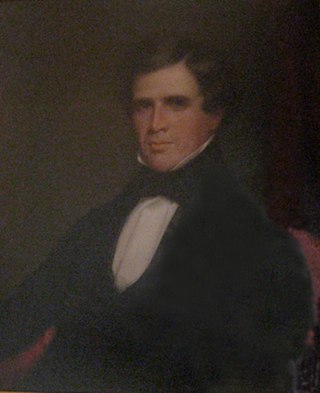
Lawrence Brainerd was an American businessman, abolitionist and United States Senator from Vermont. A longtime anti-slavery activist, after leaving the Jacksonians in the 1830s, Brainerd was active in the Whig, Liberty, and Free Soil parties, and was one of the organizers of the Republican Party when it was formed as the main anti-slavery party in the mid-1850s. Brainerd's longtime commitment to the cause of abolition was recognized in 1854, when opponents of slavery in the Vermont General Assembly chose him to fill a five-month vacancy in the United States Senate.

John Staniford Robinson was an American lawyer and politician. He is most notable for his service as the 22nd governor of Vermont, from 1853 to 1854.
The Vermont Republican Party is the affiliate of the Republican Party in Vermont and has been active since its foundation in the 1860s. The party is the second largest in the state behind the Vermont Democratic Party, but ahead of the Vermont Progressive Party. The party historically dominated Vermont politics until the mid-20th century, but was replaced by the Vermont Democratic Party. The party currently has very weak federal electoral power in the state, controlling none of Vermont's federal elected offices. The two statewide offices that the party currently controls are the governorship, held by Phil Scott, and the lieutenant governorship, held by John S. Rodgers.

The 1851 Vermont gubernatorial election was held on September 2, 1851. The state continued its support for the Whig party, and Whig Governor Charles K. Williams was easily re-elected to a one-year term. The strong showing of the Free Soil Party candidate Timothy P. Redfield also showed that Vermont was on its way to becoming an anti-slavery bastion. The Democratic nominee, John S. Robinson went on to win the governorship in 1853.

The 1853 Vermont gubernatorial election took place on September 6. The same three candidates who ran for governor of Vermont in 1852 ran again in 1853: Whig and incumbent Erastus Fairbanks, Democratic candidate John S. Robinson, and Lawrence Brainerd, the nominee of the Free Soil Party. The results showed that Fairbanks had received 43.9 percent of the vote, with Robinson receiving 38.5 percent, and Brainerd 17.6 percent.

The 1854 Vermont gubernatorial election for governor of Vermont took place on September 5. The Whig nominee was Stephen Royce, former Chief Justice of the Vermont Supreme Court. The Democratic nominee was Merritt Clark, and Lawrence Brainerd ran as the nominee of the Free Soil Party even as he was one of the organizers of the new anti-slavery Republican Party and appeared as a Whig candidate for the Vermont Senate on the ballot in Franklin County. Whig William C. Kittredge was nominated for governor against his wishes by advocates of the Temperance movement and Democrat Horatio Needham also attracted the support of some Free Soil advocates.

The 1855 Vermont gubernatorial election for governor of Vermont was held on September 4. With the Whig Party defunct after 1854, incumbent Stephen Royce, who had run with the support of both Whigs and the new Republican Party in 1854, ran as the nominee of the Republicans. The Democratic candidate was Merritt Clark, who had run unsuccessfully against Royce in 1854. James M. Slade, the Clerk of the Vermont House of Representatives was the nominee of the Know Nothing Party, also called the American Party.

The 1861 Vermont gubernatorial election for governor of Vermont was held on Tuesday, September 3. In keeping with the "Mountain Rule", incumbent Republican Erastus Fairbanks, who had also served as governor from 1852 to 1853, was not a candidate for a third one-year term. The Republican nominee was Frederick Holbrook, a former member of the Vermont Senate. With the Democratic Party split nationally over the response to the American Civil War, Andrew Tracy, a former member of the United States House of Representatives, was nominated by the People's Union Convention, which drew support from War Democrats and conservative Republicans. Benjamin H. Smalley ran as a Peace Democrat, representing Democrats who favored a compromise with the states that had formed the Confederacy.

The 1806 Vermont gubernatorial election for Governor of Vermont took place throughout September, and resulted in the re-election of Isaac Tichenor to a one-year term.

The 1813 Vermont gubernatorial election for Governor of Vermont took place in September and October, and resulted in the election of Martin Chittenden to a one-year term.

The 1847 Vermont gubernatorial election took place on September 7, 1847, and resulted in the reelection of Whig Party candidate Horace Eaton to another one-year term as governor, his second.

The 1816 Vermont gubernatorial election for Governor of Vermont took place in September and October, and resulted in the election of Jonas Galusha to a one-year term.

The 1817 Vermont gubernatorial election for Governor of Vermont took place in September and October, and resulted in the election of Jonas Galusha to a one-year term.

The 1818 Vermont gubernatorial election for Governor of Vermont took place in September and October, and resulted in the election of Jonas Galusha to a one-year term.

The 1830 Vermont gubernatorial election took place in September and October, and resulted in the election of Samuel C. Crafts to a one-year term as governor.

The 1832 Vermont gubernatorial election took place in September and October, and resulted in the election of William A. Palmer to a one-year term as governor.

The 1846 Vermont gubernatorial election took place on September 1, 1846, and resulted in the election of Whig Party candidate Horace Eaton to a one-year term as governor.

The 1834 Vermont gubernatorial election took place in September and October, and resulted in the reelection of William A. Palmer to a one-year term as governor.

The 1841 Vermont gubernatorial election was held on September 7, 1841.

The 1842 Vermont gubernatorial election was held on September 6, 1842.





















